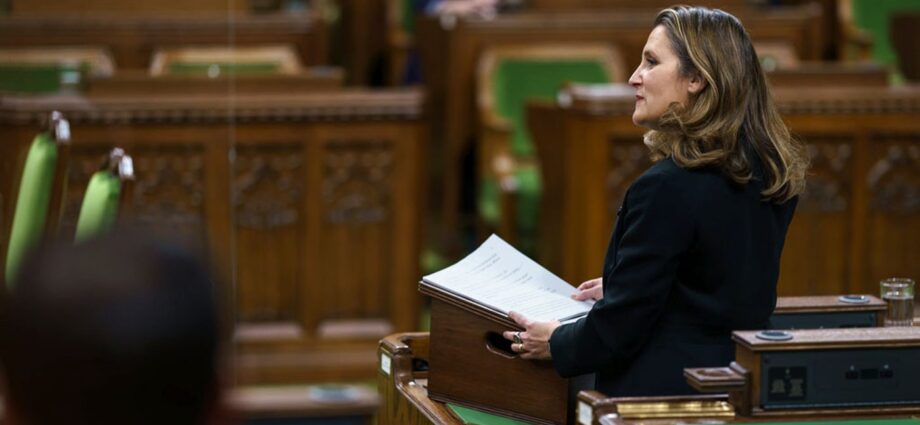
Ottawa should give taxpayers the option of realizing a capital gain on paper before the new provisions come into force.
by Luc Godbout. Originally published on Policy Options
June 8, 2024
(Version française disponible ici)
A tax countdown is underway. In the most recent federal budget, Finance Minister Chrystia Freeland announced that the proportion of the capital gain that must be included in tax returns will rise from 50 per cent to 66.67 per cent. This change will take effect very shortly, on June 25.
For individuals, the change applies only to the portion of capital gains exceeding $250,000 annually. Despite a threshold which prevents the vast majority of taxpayers from having to include more gains in their taxable income, the change has provoked strong reactions, particularly from owners of plexes and second homes. The pushback is compounded by the fact that no bill has yet been tabled in the House of Commons. The minister of finance has indicated that this will be done before Parliament adjourns, on June 21.
In this context, is the planned date of June 25 for the amendments to come into force too soon?
Taking a step back helps to better assess the situation. Historically, capital gains have always enjoyed preferential treatment compared with other forms of income (salaries, pensions, etc.). Before 1972, it was simply not taxed in Canada. Later, its inclusion rate went as high as 75 per cent, as Table 1 shows.
How were the changes made on previous occasions?
In 1971, even though it had been discussed for several years, the bill that led to the taxation of the capital gain had been tabled almost 200 days before its implementation on Jan. 1, 1972, and taxation applied only to the increase in value after that date. As for the increase of the inclusion rate applicable at the beginning of 1988, the announcement had been made in June 1987 when a white paper on tax reform was tabled, i.e. six months earlier. As with the current modifications, the rate change applied to transactions carried out after the implementation date.
At first glance, taxpayers had more time to adjust then, than now. This is all the more true given that in 1987, the Department of Finance organised a round table with the Canadian Institute of Chartered Accountants and the Canadian Bar Association to explain the effects of the tax reform. However, it was not until 15 days before such a major tax change came into effect that a ways and means motion – a prerequisite for a tax change – was tabled in Parliament. What’s more, the preliminary draft and the bill were only tabled a few months after the change became effective!
Obviously, from a best-practices standpoint, tabling the legislation detailing the current changes at the same time as the April 2024 budget would have been better. This would have greatly facilitated the work of tax advisers, but above all it would have helped taxpayers plan their affairs. Presently, some taxpayers are struggling to find the advice they need to make the best decision.
Since the minister has said she will not postpone the implementation date, are there any options to ease the transition?
Ottawa saves the day by raising capital gains tax
Les Canadiens les plus riches doivent payer plus d’impôts sur leurs revenus passifs
Offering taxpayers a choice
Once again, history may point us in the right direction. As the federal government did in 1994, it would be possible to offer taxpayers the possibility of realizing a capital gain ‘on paper,’ without a real disposition of their asset. This proposal was taken up by the joint committee on taxation of the Canadian Bar Association and the Chartered Professional Accountants of Canada.
Such a choice would allow taxpayers who wish to do so to proceed with a deemed disposition of property before the new rules come into force. In this case, the ‟sale” price could be set between the cost of the asset for tax purposes and its fair market value. Obviously, choosing this option would not be without consequences for taxpayers, as the resulting capital gain would be added to their next tax return.
With no bill in sight and the deadline looming, this choice would give taxpayers more time, given that the decision will have to be filed and sent to the tax authorities when tax returns for 2024 are filed, i.e. some time in early 2025.
It would also provide other advantages, such as avoiding hasty decisions and offering each taxpayer the possibility of realising a potential capital gain by June 25, regardless of the nature of the asset benefiting from the gain.
The question should not be whether the reform of capital gains taxation is relevant. In the long run, the advantages of the announced changes outweigh the disadvantages, and implementation of the reform should be encouraged.
Giving affected taxpayers a choice is a simple and effective solution. On the one hand, it offers flexibility; on the other, it respects the spirit of the proposed tax reform, particularly in terms of expected tax revenues for the 2024-2025 financial year.
However, given that such a provision was not included in the 2024 budget, it should be announced quickly.
Subscribe to our newsletter.
This article first appeared on Policy Options and is republished here under a Creative Commons license.

